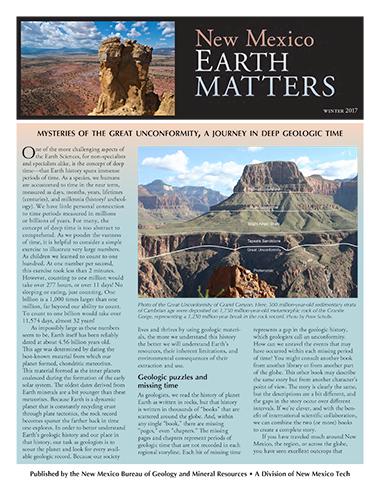
New Mexico Earth Matters — Back-issues

Vol. 17, No. 1, Winter 2017 1.52 MB
Mysteries of the great unconformity, a journey in deep geologic time
— J.M. Timmons
— J.M. Timmons
One of the more challenging aspects of the Earth Sciences, for non-specialists and specialists alike, is the concept of deep time—that Earth history spans immense periods of time. As a species, we humans are accustomed to time in the near term, measured as days, months, years, lifetimes (centuries), and millennia (history/ archeology). We have little personal connection to time periods measured in millions or billions of years. For many, the concept of deep time is too abstract to comprehend. As we ponder the vastness of time, it is helpful to consider a simple exercise to illustrate very large numbers. As children we learned to count to one hundred. At one number per second, this exercise took less than 2 minutes. However, counting to one million would take over 277 hours, or over 11 days! No sleeping or eating, just counting. One billion is a 1,000 times larger than one million, far beyond our ability to count. To count to one billion would take over 11,574 days, almost 32 years!
As impossibly large as these numbers seem to be, Earth itself has been reliably dated at about 4.56 billion years old. This age was determined by dating the best-known material from which our planet formed, chondritic meteorites. This material formed as the inner planets coalesced during the formation of the early solar system. The oldest dates derived from Earth minerals are a bit younger than these meteorites. Because Earth is a dynamic planet that is constantly recycling crust through plate tectonics, the rock record becomes sparser the farther back in time one explores. In order to better understand Earth’s geologic history and our place in that history, our task as geologists is to scour the planet and look for every available geologic record. Because our society lives and thrives by using geologic materials, the more we understand this history the better we will understand Earth’s resources, their inherent limitations, and environmental consequences of their extraction and use.


